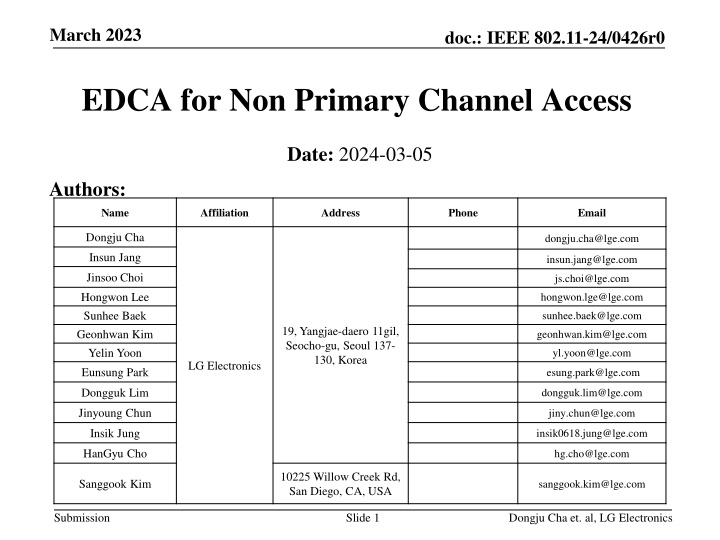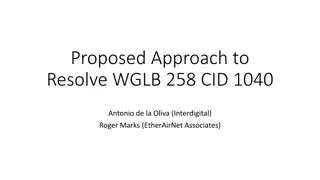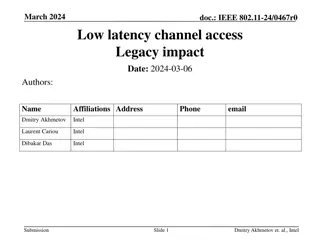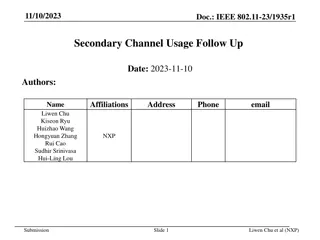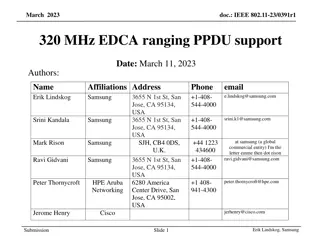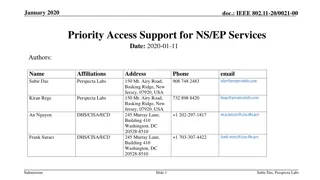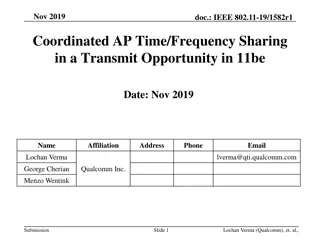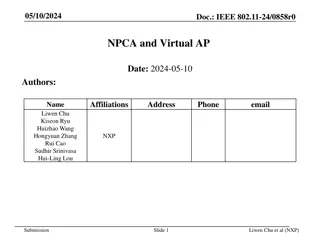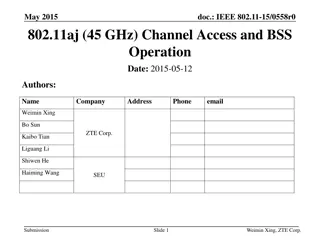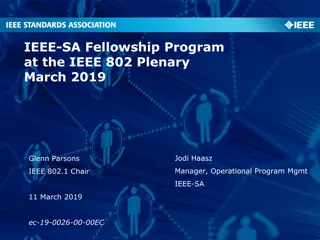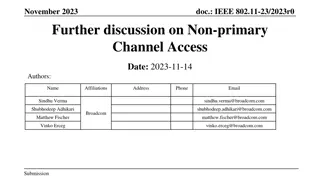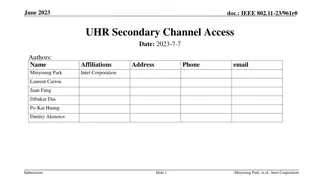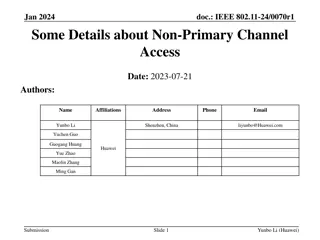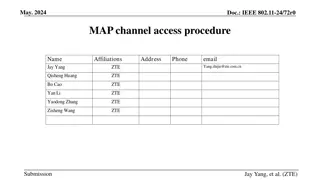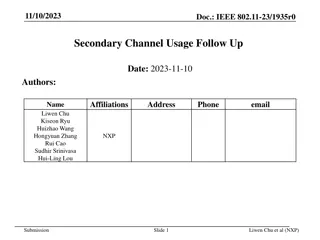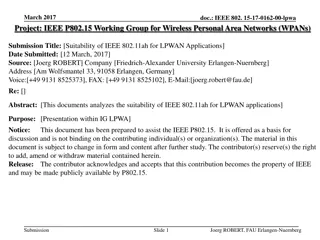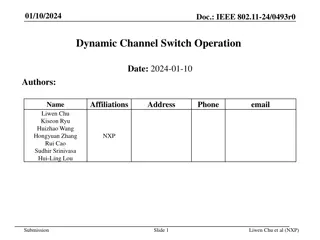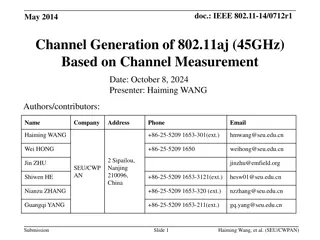Enhanced Distributed Channel Access (EDCA) for Non-Primary Channel in IEEE 802.11
Discussion on implementing EDCA for Non-Primary Channel Access (NPCA) in IEEE 802.11, focusing on mitigating frame collisions and enhancing medium efficiency. Various considerations for EDCA procedure on the Non-Primary Channel (NPCH) are explored to optimize channel access and reduce wastage. Topics include EDCA Parameter Set for NPCH, backoff counter, contention window adjustments, and AP announcements for channel prioritization.
Download Presentation

Please find below an Image/Link to download the presentation.
The content on the website is provided AS IS for your information and personal use only. It may not be sold, licensed, or shared on other websites without obtaining consent from the author.If you encounter any issues during the download, it is possible that the publisher has removed the file from their server.
You are allowed to download the files provided on this website for personal or commercial use, subject to the condition that they are used lawfully. All files are the property of their respective owners.
The content on the website is provided AS IS for your information and personal use only. It may not be sold, licensed, or shared on other websites without obtaining consent from the author.
E N D
Presentation Transcript
March 2023 doc.: IEEE 802.11-24/0426r0 EDCA for Non Primary Channel Access Date: 2024-03-05 Authors: Name Affiliation Address Phone Email Dongju Cha dongju.cha@lge.com Insun Jang insun.jang@lge.com Jinsoo Choi js.choi@lge.com Hongwon Lee Sunhee Baek Geonhwan Kim Yelin Yoon Eunsung Park hongwon.lge@lge.com sunhee.baek@lge.com 19, Yangjae-daero 11gil, Seocho-gu, Seoul 137- 130, Korea geonhwan.kim@lge.com yl.yoon@lge.com LG Electronics esung.park@lge.com Dongguk Lim dongguk.lim@lge.com Jinyoung Chun jiny.chun@lge.com Insik Jung insik0618.jung@lge.com HanGyu Cho hg.cho@lge.com 10225 Willow Creek Rd, San Diego, CA, USA Sanggook Kim sanggook.kim@lge.com Submission Slide 1 Dongju Cha et. al, LG Electronics
March 2023 doc.: IEEE 802.11-24/0426r0 Introduction To improve medium efficiency of the large bandwidth, Non- Primary Channel Access (NPCA) has been discussed in several contributions in UHR SG and 11bn TG [1]~[9] STA(s) performing NPCA need to perform EDCA procedure on the Non-Primary Channel (NPCH) to mitigate the frame collision that may lead to the medium wastage To perform EDCA procedure on the NPCH, few considerations need to be discussed (see next slide) Submission Slide 2 Dongju Cha et. al, LG Electronics
March 2023 doc.: IEEE 802.11-24/0426r0 Recap: Non-Primary Channel Access (NPCA) In the previous contribution, we ve shared our thoughts on EDCA procedure w/ some restrictions for medium access recovery when STA(s) switches to NPCH [1] Attempt to obtain a TXOP shall be initiated w/ short control frame (e.g., RTS) using regular EDCA backoff using baseline CCA but TBD ED threshold value In this contribution, we discuss the EDCA procedure EDCA Parameter Set for NPCH Backoff Counter and Contention Window for NPCH Wide Bandwidth Frame Transmission Submission Slide 3 Dongju Cha et. al, LG Electronics
March 2023 doc.: IEEE 802.11-24/0426r0 EDCA Parameter Set for NPCH To perform channel access on the NPCH, AP shall announce EDCA Parameter Set for NPCH Option 1: Seperate EDCA Parameter Set for NPCH (Preferred) AP can consider each of the channel condition for PCH / NPCH and announce the separate EDCA Parameter Set for NPCH while reusing the existing format With this, AP can adjust the prioritization of the PCH and NPCH EDCA Parameter Set for NPCH may have lower priority compared to the PCH To reduce the impact on the STAs on OBSS E.g., MU EDCA Parameter Set can be adapted for the NPCH Option 2: EDCA Parameter Set for PCH can be shared w/ NPCH However, not to affect the channel access each other, CW and BC is updated and maintained seperately on PCH and NPCH while sharing the EDCA Parameter Set Submission Slide 4 Dongju Cha et. al, LG Electronics
March 2023 doc.: IEEE 802.11-24/0426r0 BC and CW for NPCH STA(s) performing NPCA switches its channel that performs channel access dynamically from the PCH to the NPCH (vice versa) How to maintain the BC and CW on the NPCH need to be discussed Option 1: Maintain the BC and CW that STA used last time when it performed channel access on the NPCH (Preferred) When maintaining the CW, frame collision may be reduced since the channel condition of the previous channel access on the NPCH is considered When maintaining the BC, fairness of channel access opportunity among STAs in BSS can be guarateed Option 2: Initialize the BC and CW whenever STA(s) switches to the NPCH E.g., STA sets its BC to a random value selected from [0, CWmin] Simple to design / Memory overhead can be reduced Submission Slide 5 Dongju Cha et. al, LG Electronics
March 2023 doc.: IEEE 802.11-24/0426r0 Wide Bandwidth for NPCA According to the current spec (REVme) , STA(s) are able to transmit N MHz PPDU according to EDCA channel access rule The width of transmission is determined by the CCA status of the nonprimary channels during an interval of duration before transmission To define EDCA channel access for NPCA, primary N MHz and secondary N MHz for NPCA may need to be defined Submission Slide 6 Dongju Cha et. al, LG Electronics
March 2023 doc.: IEEE 802.11-24/0426r0 Primary N MHz and Secondary N MHz for NPCA NPCA Primary Channel and NPCA Secondary Channel can be defined as follows NPCA P20: 20MHz CH that STA contends for NPCA NPCA S20: 20MHz CH adjacent to the NPCA P20 that together forms the NPCA P40 NPCA P40: 40MHz CH including NPCA P20 that is used to transmit 40MHz PPDU NPCA S40: 40MHz CH adjacent to the NPCA P40 that together forms the NPCA P80 NPCA P80: 80MHz CH including NPCA P20 that is used to transmit 80MHz PPDU NPCA S80: 80MHz CH adjacent to the NPCA P80 that together forms the NPCA P160 NPCA P160: 160MHz CH including NPCA P20 that is used to transmit 160MHz PPDU NPCA S160: 160MHz CH not including NPCA P20, which together w/ the NPCA P160, forms the 320MHz channel Submission Slide 7 Dongju Cha et. al, LG Electronics
March 2023 Wide Bandwidth Frame Transmission for NPCA doc.: IEEE 802.11-24/0426r0 To obtain EDCA TXOP on NPCH, STA(s) performs back-off on NPCA P20 and when BC reaches 0, a PPDU including Frame(s) can be transmitted on NPCA P20 including other IDLE NPCH(s) according to the CCA results Transmits 20MHz PPDU on the NPCA P20 Transmits 40MHz PPDU on the NPCA P40 Transmits 80MHz PPDU on the NPCA P80 Transmits 160MHz PPDU on the NPCA P160 Transmits 320MHz PPDU on the NPCA P320 If NPCA S20, NPCA S40, NPCA S80 and NPCA S160 were idle during an interval of PIFS immediately preceding the start of TXOP Submission Slide 8 Dongju Cha et. al, LG Electronics
March 2023 doc.: IEEE 802.11-24/0426r0 Conclusion In this contribution, we ve proposed EDCA for NPCA EDCA Parameter Sets for NPCH How to maintain backoff counter and contention window value whenever STA switches between the PCH and SCH Define Primary N MHz and Secondary N MHz for NPCA Wide bandwidth frame transmission can be done based on defined Primary N MHz and Secondary N MHz for NPCA Submission Slide 9 Dongju Cha et. al, LG Electronics
March 2023 doc.: IEEE 802.11-24/0426r0 Reference [1] 23/1112r0, Thoughts on Secondary Channel Access [2] 23/1911r0, Secondary Channel Access and Frame Transmission [3] 23/034r1, Non-primary Channel Utilization [4] 23/1444r1, Non-primary channel access evaluations_followup [5] 23/1419r0, Nonprimary channel access discussions [6] 23/1365r0, Discussions on Non-primary Channel Access [7] 23/797r0, Non-primary channel access [8] 23/1288r0, Non-primary Channel Utilization Follw-up [9] 23/1414r0, secondary channel usage follow up Submission Slide 10 Dongju Cha et. al, LG Electronics
March 2023 doc.: IEEE 802.11-24/0426r0 SP1 Do you agree to include the following into the 11bn SFD? AP shall announce an separate EDCA Parameter Set for performing channel access on a non-primary channel Detailed signaling is TBD Submission Slide 11 Dongju Cha et. al, LG Electronics
March 2023 doc.: IEEE 802.11-24/0426r0 SP2 Do you agree to include the following into the 11bn SFD? STA shall maintain backoff counter and contention window it used last time when it performed channel access on a non-primary channel Submission Slide 12 Dongju Cha et. al, LG Electronics
March 2023 Appendix: Example of Backoff Procedure on NPCH doc.: IEEE 802.11-24/0426r0 Below example figure adapts EDCA Parameter Set for NPCH (on slide 4) option 1 and BC / CW for NPCH (on slide 5) option 1 When STA performs NPCA, STA maintains its CW value (e.g., 31) and BC (e.g., 7 which is remaining BC from previous NPCA) used from previous channel access on the NPCH Switching back to the PCH does not affect the backoff procedure (in terms of BC and CW value) on the NPCH Submission Slide 13 Dongju Cha et. al, LG Electronics
